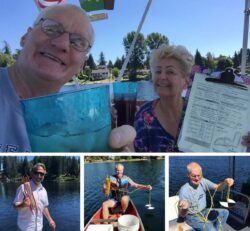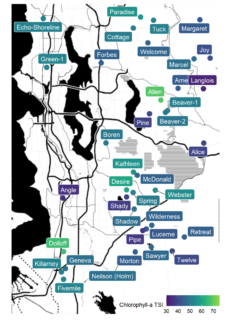by Wafa Tafesh, Water Quality Planner, Science and Technical Support Section, King County Water and Land Resources Division
The 2020 Lake Stewardship monitoring season was unusual to say the least. When routine annual monitoring was supposed to start in May, we were already two months into lockdown amidst the COVID-19 global pandemic. At King County Water and Land Resources Division, along with many other office and on-site workers, we were directed to work from home. All over the country, large gatherings were banned and events were postponed or canceled. We all started using video call applications and Zoom fatigue set in faster than we expected.

Lake stewardship volunteers having fun collecting data (Counter-clockwise starting from top: Bruce and Sandy Goulet, Angle Lake; Bassem Bejjani, Beaver Lake; Mark Reeves, Shady Lake; Bruce Goulet, Angle Lake)
For the Lake Stewardship monitoring program, after numerous phone and video calls to “check in” and “see how things are going,” we were proud to be one of the first King County programs to begin sampling after COVID-19 restrictions and safety precautions were established. This was a huge feat since the Lake Stewardship program is no small monitoring program. With 38 lakes monitored in 2020, we were delivering between 76 and 230 bottles to our King County Environmental Lab to be analyzed for four to eight different parameters every two weeks May through October.
We still had some obstacles: in 2020, samples were collected at 10 of the 12 sampling events usually held throughout the summer. The first May event was missed as we worked out appropriate safety precautions and lab coordination, and the first September event was canceled due to heavy smoke around the region, making it unsafe for our volunteers to be outdoors.
Thank you!!
The biggest thanks for the monitoring season continuing throughout the pandemic go to the King County Environmental Lab for analyzing all samples with limited staff capacity — and to our wonderful Lake Steward volunteers!
Our volunteers welcomed the monitoring season for bringing some sense of “normalcy.” And as always, they had fun being stewards of their lake!
2020 Monitoring Reports
The 2020 monitoring reports were published in April and can be viewed from the King County individual lake page or the complete compiled report. For each lake, the report starts with key takeaways from the monitoring season and program recommendations, followed by water quality results and trends. Results from 2020 are compared to other lakes within the program and long-term annual averages are used to highlight any long-term trends.
Lakes in lowland King County have a range of different natural trophic states, and human activities may also alter a lake’s trophic state (usually by changing nutrient inputs). As an overall comparison among lakes, this map shows the trophic state for each lake in the King County Lake Stewardship program in 2020. The color of each circle indicates the lake’s average chlorophyll-a TSI (trophic state index) value for the year.
Harmful Algal Blooms
Through the Lake Stewardship Program, we empower citizens to act as stewards of their lakes and watersheds through education and outreach. A hot topic every year with our volunteers is blue-green algae or cyanobacteria, which have the potential to produce toxins that can present health risks to people and animals. Through the Washington State Toxic Algae Program bloom samples are submitted for toxicity testing.
In 2020, our volunteers helped coordinate, collect, and submit algae samples for 12 lakes experiencing algae blooms. Of those, three lakes had elevated concentrations of algal toxins and two lakes experienced a prolonged bloom throughout the season – Cottage Lake in Woodinville and Lake Desire in Renton. View all algal toxin data on the Northwest Toxic Algae webpage at: https://www.nwtoxicalgae.org/.
HOW CAN I GET INVOLVED?
Monitoring is a key part of good lake stewardship, as it builds a valuable long-term data set to guide lake management and detect future problems. For those reasons, we are always looking for new volunteers to serve as monitors and back-up monitors.
Volunteers need to have their own watercraft, and will head out on the lake 12 times from May through October to take measurements and collect samples. King County will provide training, sampling equipment, and will pick up water samples to deliver to our Environmental Laboratory.
We are currently looking for volunteers who live on or near Langlois Lake in Carnation. And if you are interested in being a back-up monitor, check this site first to see if your lake is being actively monitored.
If you are interested in volunteering or would like to learn more about the program, please contact Wafa Tafesh (wtafesh@kingcounty.gov) or Chris Knutson (chris.knutson@kingcounty.gov).











